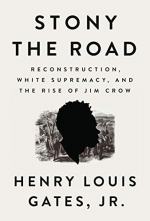
|
| Name: _________________________ | Period: ___________________ |
This test consists of 15 multiple choice questions and 5 short answer questions.
Multiple Choice Questions
1. In what year did African American men gain the right to register and vote?
(a) 1895.
(b) 1833.
(c) 1867.
(d) 1901.
2. Gates asserts in Part Two that monogenesis "found its basis" (57) in what element of society?
(a) Religion.
(b) Science.
(c) Folklore.
(d) Astrology.
3. Gates asserts in Part Two that "adherents to polygenesis" (57) turned to what element of society?
(a) Science.
(b) Religion.
(c) Folklore.
(d) Mathematics.
4. In what type of matter did the Freedmen's Bureau NOT aid former slaves once it was formed?
(a) Agricultural.
(b) Educational.
(c) Legal.
(d) Medical.
5. From which two Greek words did the term eugenics spring?
(a) Power and grace.
(b) Well and born.
(c) Best and brightest.
(d) Just and true.
6. What event "compelled many Northern white people to acknowledge the humanity of black people" (65)?
(a) The election of black men to the U.S. Senate.
(b) The popularity of the film The Birth of a Nation.
(c) The Underground Railroad.
(d) Black military service in the Civil War.
7. In what year did the Plessy vs. Ferguson case lead to widespread segregation?
(a) 1866.
(b) 1932.
(c) 1854.
(d) 1896.
8. In what year was the "nation's first federal civil rights law" (6) enacted?
(a) 1843.
(b) 1866.
(c) 1892.
(d) 1850.
9. Which term was synonymous with miscegenation in the post-Civil War era?
(a) Amalgamation.
(b) Reclamation.
(c) Abomination.
(d) Intermingling.
10. In what time period did a particular physiologist develop the pseudoscience of phrenology?
(a) The late 1800s.
(b) The mid-1700s.
(c) The mid-1800s.
(d) The early 1800s.
11. In what capacity was Louis Agassiz hired by a particular institution of higher learning in 1846?
(a) As a professor of anthropology.
(b) As a professor of biology.
(c) As a professor of natural history.
(d) As the dean of students.
12. In what year was the Fourteenth Amendment ratified?
(a) 1868.
(b) 1878.
(c) 1900.
(d) 1888.
13. The pseudoscience of phrenology was founded by a physiologist from what country?
(a) The United States.
(b) Germany.
(c) Denmark.
(d) Belgium.
14. What was the main premise behind the theory of polygenesis?
(a) The notion that black people were a separate race from white people.
(b) The notion that each race of people on earth should have its own leader.
(c) The notion that every race had had its own creator.
(d) The notion that there was an inherent hierarchy within each racial group.
15. Rudolph Matas reached how many conclusions within his work entitled The Surgical Peculiarities of the American Negro?
(a) 22.
(b) 11.
(c) 3.
(d) 43.
Short Answer Questions
1. What location is cited as having been the "center of eugenics thought in the United States" (76)?
2. In what year was the Fifteenth Amendment ratified?
3. Many eugenicists took the hereditary theories of which scientist and then applied them to humans?
4. Benjamin Franklin Perry claimed in an 1866 newspaper article that all Africans rightfully inhabited one of which two roles?
5. Phrenology argued for a connection between mental capacity and what?
|
This section contains 439 words (approx. 2 pages at 300 words per page) |

|




